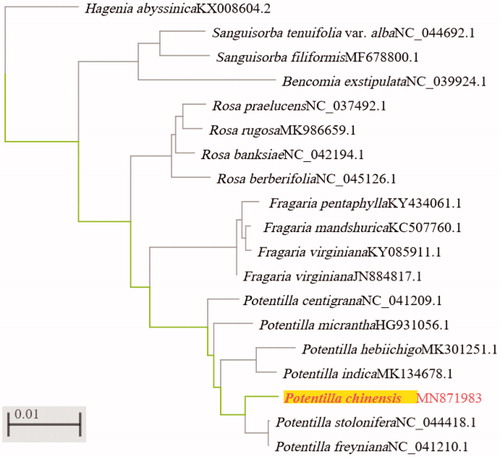Abstract
Potentilla chinensis is traditional Chinese medicine source species. The cp genome of P. chinensis showed a typical quadripartite cycle with 157,117 bp, including a pair of inverted repeat regions (IRa and IRb, 26,194 bp each), a large single-copy region (LSC, 85,989 bp), and a small single-copy region (SSC, 18,740 bp). 129 unique genes were assembled in the cp genome, including 84 protein genes, 37 tRNA genes, and 8 rRNA genes. Phylogenetic analysis based on 17 cp genome of related species of Rosaceae showed that the P. chinensis was closely related to Potentilla stolonifera and Potentilla freyniana. This study provides important information for identification and application of P. chinensis.
Potentilla chinensis is a widespread species in China. It belongs to Rosaceae. Potentilla chinensis is so similar to Potentilla discolor in morphology that often leads to wrong identification. As P. chinensis is a kind of traditional Chinese medicine source species (named Potentillae chinensis herba, State Pharmacopoeia Committee, Citation2015), which is mainly used to treat dysentery, hemorrhoids, and cancer (Wan et al. Citation2016). Here, the chloroplast genome of P. chinensis was assembled. Studies on cp DNA genome will provide more evidence for the identification and application of P. chinensis.
Five grams of fresh leaves of a single individual of P. chinensis were sampled from Nanxiaohegou Watershed, Qingyang, Gansu Province, China (107°34′5′′E, 35°42′51′′N) (Jin et al. Citation2014). A voucher specimen (WNU52013) was deposited at the herbarium, in the Schools of Life Sciences, Northwest University. Genomic DNA was extracted modified CTAB method (Doyle Citation1987). Total DNA was used for library construction and then sequencing on Illumina HiSeq 4000 System. Illumina reads were mapped to the assembly assembled by MITObim v1.8 (Hahn et al. Citation2013) with the reference sequence of Potentilla stolonifera (NC_044418). The complete cp genome was submitted to GenBank (accession number: MN871983).
The complete cp genome length of P. chinensis was 157,117 bp, with a large single-copy (LSC, 85,989 bp), a small single-copy (SSC,18,740 bp), and two inverted repeats (IRa and IRb, 26,194 bp each). The total GC content of P. chinensis cp genome was 36.79%. The cp genome of P. chinensis contained 129 genes, including 84 protein-coding genes, 37 tRNA genes, and 8 rRNA genes. A total of 32 genes were duplicated in the IR regions, including 10 protein-coding genes, 14 tRNA genes, and 8 rRNA genes. The ycf1 gene was located at the SSC and IRa junction.
To investigate the phylogenetic relationships with closely related species, the neighbor-joining(NJ) phylogenetic tree was constructed by BLAST tools on NCBI (https://blast.ncbi.nlm.nih.gov) based on 18 complete chloroplast genome (download from Genbank, ) of species of Rosaceae. A thousand bootstrap replicates were computed to confirm the stability of each tree node. The tree showed a close relationship among P. chinensis, P. stolonifera and Potentilla freyniana. The complete cp genome sequence of P. chinensis can benefit further studies on its application and identification.
Disclosure statement
No potential conflict of interest was reported by the author(s).
Additional information
Funding
References
- Doyle JJ. 1987. A rapid DNA isolation procedure for small quantities of fresh leaf tissue. Phytochem Bull. 19:11–15.
- Hahn C, Bachmann L, Chevreux B. 2013. Reconstructing mitochondrial genomes directly from genomic next-generation sequencing reads-abaiting and iterative mapping approach. Nucleic Acids Res. 41(13):e129.
- Jin Z, Dong Y, Wang Y, Wei X, Wang Y, Cui B, Zhou W. 2014. Natural vegetation restoration is more beneficial to soil surface organic and inorganic carbon sequestration than tree plantation on the Loess Plateau of China. Sci. Total Environ. 485-486:615–623. doi:10.1016/j.scitotenv.2014.03.105.
- State Pharmacopoeia Committee. 2015. Chinese Pharmacopoeia Commission., 2015 version Beijing (China): China Medical Science Press; p. 214.
- Wan G, Tao J-G, Wang G-D, Liu S-P, Zhao H-X, Liang Q-D. 2016. In vitro antitumor activity of the ethyl acetate extract of Potentilla chinensis in osteosarcoma cancer cells. Mol Med Rep. 14(4):3634–3640.

